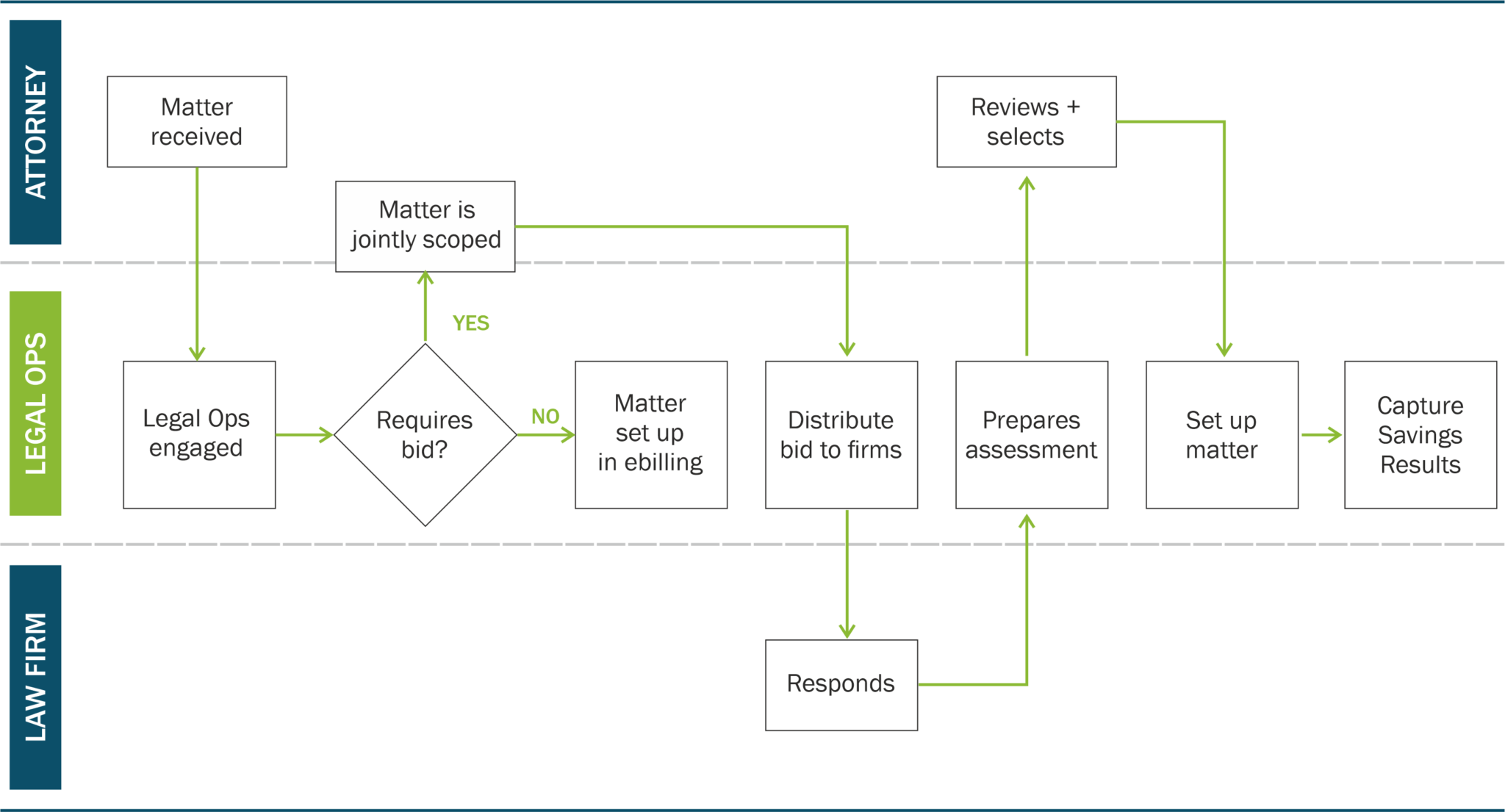Outside Counsel Management: Thoughts on Elevate Select
January 09, 2020
As the influence of Legal Operations and the need to be data-driven increases, it has become increasingly important for legal departments to be able to track time, spend, and outcomes from matter to matter. While eBilling systems have become table stakes for mature legal departments to manage those metrics once firms are engaged, the strategy around proper engagement of firms before a matter is set up in eBilling still remains unclear. This can be traced to 3 key issues: 1) Stakeholder Role Clarity, 2) Incomplete Process Definition, and 3) Lack of Simplified Tools or Technology.
Stakeholders: Strengths and Weaknesses
One of the challenges we face in the legal industry is the complex relationship between stakeholders and suppliers. Unlike other purchased services, there are multiple stakeholders that should have a hand in the engagement process, each with potentially different objectives. Depending on your organization’s structure and needs, these stakeholders can exert different influences on matter engagement.
- In-House Attorney: Best positioned to judge the fit of the firm for the work, but given their relationship may not be able to judge the price or the expectations.
- Legal Operations: Have a broad base of knowledge across the legal department, their primary focus is ensuring the work is delivered, billed, and budgeted appropriately. They can be an asset to maintaining a positive engagement, but can also cause friction if they overapply process.
- Procurement: Capable negotiators, focused on ensuring fiscally responsible decisions which can be an important control, but a lack of expertise in the subject can result in pennywise, pound foolish choices.
Each of the three roles can add value to an engagement decision, but an imbalance of ownership could result in incomplete or incorrect decisions that doom the matter…wrong firm, wrong price, wrong measurements.
Matter Engagement Process: Picking the Right Restaurant
To be clear, I believe that the in-house attorney is the right person to select the firm to engage, but they should be given the right information and support so that they can make the informed choice. The lack of clarity between selecting a firm versus initiating a matter engagement request is, I think, a root cause of the current challenges in matter selection. While the final decision on whom to work with should rest with the in-house counsel, most developing legal departments still bundle the act of initiating a search with the decision regarding selection.
It seems unfair to assume that the attorney is picking favorites maliciously, no more so than I should be accused of an ulterior motive for picking the same Italian restaurant when my wife wants to go out for dinner. I have personal experience with that one restaurant, enjoy it, and have no further information on other restaurants. Also they heavy pour their Chianti, so that’s a pretty good thing.
Notwithstanding the extra wine, both I and the in-house attorney may be going with who we know, rather than what might be best, likely because we are busy or uninformed. As a result, we unfairly roll our eyes and assume that in-house attorneys still select firms on an informal basis, when the current process does not give them the ability to separate the choice from the request.
To help our customers make the right choice, we are helping legal departments separate the request from the selection. We believe that this is the best way to encourage participation from all three stakeholders to produce a data-driven, informed result. Here is how we are changing process:

By separating the initiation request from the selection decision, we are enabling all three stakeholders to participate in the process and add value where they can best support:
- Legal Operations – maintains the overall process and captures data on the selection process
- Procurement – supports more challenging negotiations where needed; captures costs savings
- In-House Attorney – retains the decision-maker role, but with more robust information and the appropriate separation from the law firms (if needed)
The right roles and the right process are key to managing the initiation and selection process. Without that foundational clarity, organizations will struggle to move away from a relationship-driven engagement. Conversely, a well-defined team can make fully informed decisions and, as they mature, can start to distribute decision-making ownership away from the In-House Attorney where it makes sense, such as for lower-stakes matters.
Technology: Facilitating Workflow and Data Capture
Mature legal departments that have ironed out their engagement process are now, as they are across the entire department, looking for technology augmentation to drive further efficiency. Our customers are beginning their journey with the basics, i.e.:
- A process playbook
- A bid form or selection template
- A scorecard and benefit model
These tools can easily be templatized by the legal operations manager and managed as a service. For a more robust technology solution, customers are leveraging our Elevate Select engagement tool to automate workflow and approvals, capture savings results, and facilitate the development of robust phase and task level matter scoping. In addition to driving results, these selection tools help departments manage the matter at a more granular level, as well as automate or redistribute the selection process for less critical matters.
Conclusion
For many organizations, matter initiation and selection remain intertwined, resulting in choices that are more relationship-sourced rather than transparent and data-driven. While the In-House Attorney should own the ultimate choice, getting to that decision needs to involve a clear process that engages each of the three key stakeholders – Legal Operations, Procurement, and the In-House Attorney. Companies that identify the proper stakeholders for the selection and engagement process can create a more efficient, data-driven, and informative process that allows the right people to make the right decisions. Those that have developed a comprehensive outside counsel management program are now leveraging selection tools to streamline their process, capture benefits, and get a grip on more active matter management once engaged.
Back to Expertise

 Peter Eilhauer
Peter Eilhauer